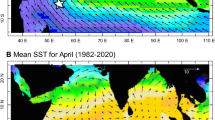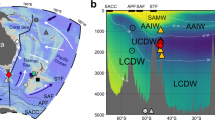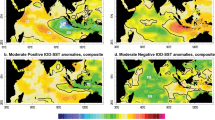Abstract
Research on global climate change has increasingly focused on rapid (century-scale and decadal) changes. One such climate shift, the Younger Dryas cooling event1, took place during the last deglaciation, from 13,000 to 11,700 years BP. Climate records from Greenland ice cores and North Atlantic sediment cores show high-frequency fluctuations implying significant (>5 °C) shifts in temperature at this time, taking place within 50–100 years (ref. 2). The origin of the Younger Dryas has recently been attributed to a reduction or cessation of deep-water production in the North Atlantic and a concurrent lessening of the heat flux from low latitudes3,4. The role of intermediate waters (1,000–2,000 m depth) is less certain, however, because climate proxies for this ocean reservoir are rare and ambiguous. Here we report on the use of a new climate archive, deep-sea corals from Orphan knoll (1,600m depth) in the northwestern Atlantic Ocean. The oxygen isotope ratios in the coral skeletons (accurately dated by the 230Th/234U chronometric method) change markedly coincident with the initiation of the Younger Dryas, suggesting that there were profound changes in intermediate-water circulation at this time.
This is a preview of subscription content, access via your institution
Access options
Subscribe to this journal
Receive 51 print issues and online access
$199.00 per year
only $3.90 per issue
Buy this article
- Purchase on Springer Link
- Instant access to full article PDF
Prices may be subject to local taxes which are calculated during checkout
Similar content being viewed by others
References
Fairbanks, R. G. The age and origin of the Younger Dryas event in Greenland ice cores. Paleoceanography 5, 937–948 (1990).
Johnsen, S. J. et al. Irregular glacial interstadials recorded in a new Greenland ice core. Nature 359, 311–313 (1992).
Broecker, W. S. & Denton, G. H. The role of ocean–atmosphere reorganization in glacial cycles. Geochim. Cosmochim. Acta 53, 2465–2501 (1989).
Broecker, W. S., Peteet, D. M. & Rind, D. Does the ocean–atmosphere system have more than one stable mode of operation? Nature 315, 21–26 (1986).
Stanley, G. D. Jr & Cairns, S. D. Constructional azooxanthellate coral communities: an overview with implications for the fossil record. Palaios 3, 233–242 (1988).
Druffel, E. R. M., King, L. L., Belastock, R. A. & Duesseler, K. O. Growth rate of a deep-sea coral using Pb-210 and other isotopes. Geochim. Cosmoschim. Acta 54, 1492–1500 (1990).
Mikkelson, N., Erlenkeuser, H., Killingley, J. S. & Berger, W. H. Norwegian corals: radiocarbon and stable isotopes in Lopheha pertusa. Boreas 11, 163–171 (1982).
Emiliani, C., Hudson, J. H., Shinn, E. A. & George, R. Y. Oxygen and carbon isotopic growth records in a reef coral from Florida Keys and a deep-sea coral from Blake Plateau. Science 202, 627–629 (1978).
Smith, J. E. et al. Isotopic analyses of deep-sea corals yield climatic information after compensating for kinetic isotope effects. (Spring Meeting Suppl.) Eos 77, S160 (1996).
McConnaughey, T. A. C-13 and O-18 isotopic disequilibrium in biological carbonates I: Patterns. Geochim. Cosmochim. Acta 53, 151–163 (1989).
McConnaughey, T. A., Burdett, J., Whelan, J. F. & Paull, C. K. Respiration and photosynthesis: effects on the carbon-13 content of biological carbonates. Geochim. Cosmochim. Acta 61, 611–622 (1997).
Grossman, E. L. & Ku, T. L. Oxygen and carbon isotope fractionation in biogenic aragonite: temperature effects. Chem. Geol. 59, 59–74 (1986).
Keen, C. E. Cruise Report, C.S.S. Hudson 78-020 (Atlantic Geoscience Centre, Dartmouth, 1978).
Schumacher, H. & Zibrowius, H. What is hermatypic? A redefinition of ecological groups in corals and other organisms. Coral Reefs 4, 1–9 (1985).
Smith, J. E. Late Quaternary climate reconstruction using the deep-water coral Desmophyllum cristagalli. Geol. Surv. Canada Open File 2950 (1994).
Broecker, W. S. et al. Radiocarbon age of waters in the deep Atlantic. Glob. Biogeochem. Cycles 4, 103–117 (1990).
Lehman, S. J. & Keigwin, L. D. Sudden changes in North Atlantic circulation during the last deglaciation. Nature 356, 757–762 (1992).
Woillard, G. M. & Mook, W. D. C-14 dates at Grande Pile: correlation of land and sea chronologies. Science 215, 159–161 (1982).
Coope, G. R. Fossil coleopteran assemblages as sensitive indicators of climate change during Devensian (last) cold stage. Phil. Trans. R. Soc. B 280, 313–340 (1977).
Lehman, S. J., Wright, D. G. & Stocker, T. F. Global Climate Change Vol. 12, Ice in the Climate System 187–209 (NATO ASI Ser. 1, Kluwer Academic Norwell, 1993).
Boyle, E. A. Cadmium: chemical tracer of deepwater paleoceanography. Paleoceanography 3, 471–489 (1988).
Yu, E.-F., Francois, R. & Bacon, M. P. Similar rates of modern and last-glacial ocean thermohaline circulation inferred from radiochemical data. Nature 379, 689–694 (1996).
Samthein, M. et al. Changes in east Atlantic deepwater circulation over the last 30,000 years: eight time slice reconstructions. Paleoceanography 9, 209–267 (1994).
Labeyrie, L. D. et al. Changes in the vertical structure of the North Atlantic ocean between glacial and modern times. Quat. Sci. Rev. 11, 301–413 (1992).
Oppo, D. W. & Lehman, S. J. Mid-depth circulation of the subpolar North Atlantic during the last glacial maximum. Science 259, 1148–1152.
CLIMAP The last interglacial ocean. Quat. Res. 21, 123–224 (1984).
Alley, R. B. et al. Abrupt increase in Greenland snow accumulation at the end of the Younger Dryas event. Nature 342, 527–529 (1993).
Fairbanks, R. G. A 17,000 years glacio-eustatic sea-level record: influence of glacial melting rates on the Younger Dryas event and deep ocean circulation. Nature 342, 637–642 (1989).
Blanchon, P. & Shaw, J. Reef drowning during the last deglaciation: evidence for catastrophic sea-level rise and deep-ocean circulation. Geology 23, 4–8 (1995).
Dunbar, R. B. & Cole, J. E. Coral records of ocean–atmosphere variability. Special Rep. No. 10 (NOAA Climate and Global Change Program, Silver Springs, MD, 1993).
Author information
Authors and Affiliations
Rights and permissions
About this article
Cite this article
Smith, J., Risk, M., Schwarcz, H. et al. Rapid climate change in the North Atlantic during the Younger Dryas recorded by deep-sea corals. Nature 386, 818–820 (1997). https://doi.org/10.1038/386818a0
Received:
Accepted:
Issue Date:
DOI: https://doi.org/10.1038/386818a0
This article is cited by
-
Influence of the upwelling events on the δ13C and δ18O of the benthic bivalve shells of the South Western Continental Margin of India
Environmental Earth Sciences (2016)
-
Micro-X-ray fluorescence-based comparison of skeletal structure and P, Mg, Sr, O and Fe in a fossil of the cold-water coral Desmophyllum sp., NW Pacific
Geo-Marine Letters (2014)
-
Erratum: Corrigendum: Rapid climate change in the North Atlantic during the Younger Dryas recorded by deep-sea corals
Nature (2013)
-
Modal analysis of the deep-water solitary scleractinian, Desmophyllum dianthus, on SW Pacific seamounts: inferred recruitment periodicity, growth, and mortality rates
Coral Reefs (2011)
-
Climate reconstructions and monitoring in the Mediterranean Sea: A review on some recently discovered high-resolution marine archives
RENDICONTI LINCEI (2008)
Comments
By submitting a comment you agree to abide by our Terms and Community Guidelines. If you find something abusive or that does not comply with our terms or guidelines please flag it as inappropriate.



